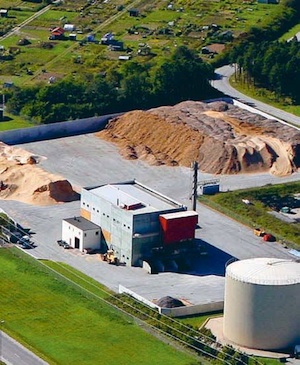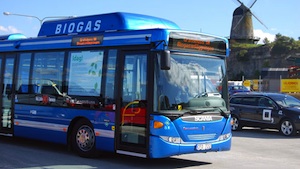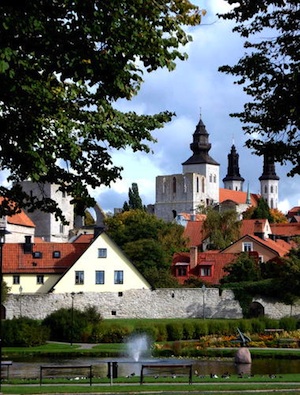Bio-fuelled district heating
A former Viking site on the island of Gotland, Visby was the main centre of the Hanseatic League in the Baltic from the 12th to the 14th century. Its 13th-century ramparts and more than 200 warehouses and wealthy merchants’ dwellings from the same period make it the best-preserved fortified commercial city in northern Europe.
En tant qu'élément de la préservation des bâtiments de Visby, construction d'un réseau de chauffage urbain a commencé quelque 30 il ya des années. Maintenant, toute la chaleur dans le système de chauffage urbain de Visby est produit en utilisant un mélange d'énergies renouvelables.
Visby’s district heating project is not an isolated case on an island where the use of renewable is guaranteed. Gotland is a showcase for a number of interesting and innovative renewable energy initiatives. This is not really surprising. Gotland has Sweden’s highest sunshine figures, enjoys good access to biofuels and is one of the best European locations for wind power. Photo Gallery, the entrepreneurship of the islanders and the municipality’s focus on strategic environmental planning have led to the realisation of many ideas for increasing the sustainability of Gotland’s local energy supply.
Biocarburants dans le chauffage urbain de Visby
The World Heritage City of Visby consists of many unique buildings and mediaeval ruins that are built from limestone. Certains de ses bâtiments les plus anciens ont aussi magnifiquement portails et frises sculptées en grès Gotland. Ces deux pierres sont sensibles aux contaminants de l'air et, en particulier, émissions provenant de la combustion de combustibles fossiles.
En Visby dans son ensemble, district le chauffage représente plus de 80 pour cent de tout le chauffage fourni aux locaux commerciaux et des logements. Pour le bénéfice des résidents de Visby et le patrimoine de la ville, ce chauffage contribue à une société durable.
Environmental benefits are evident, since fossil fuels have not been used in Visby’s district heating since 2006. Chauffage urbain élimine la nécessité pour le transport de carburant dans les rues étroites du centre-ville de Visby. Par ailleurs, the use of biofuels reduces the emission of sulphur and nitrogen oxides. Par rapport à l'utilisation de combustibles fossiles, Il abaisse aussi la plus nette de dioxyde de carbone dans l'atmosphère.
Depuis 1980, émissions de soufre provenant du chauffage urbain de Visby ont chuté de 95 pour cent. En comparaison avec chauffage individuel, chauffage urbain laisse l'air plus propre et plus sain pour les résidents de Visby et le patrimoine culturel sensible de la ville.
Le réseau de chauffage urbain à Visby prend sa chaleur à partir de:
- Bark, brindilles, rameaux et autres (ébréché) résidus de dégagements forestiers et des scieries.
- Une pompe à chaleur à base d'eau de mer avec un 11 Capacité MW.
- Le biogaz provenant du site d'enfouissement fermé maintenant à Visby.
- Biogaz à partir de la station de traitement des eaux usées.
- Bio-huiles qui remplacent les huiles fossiles.
In addition to that, the municipality has set very high standards for energy efficiency and they have launched a new plan for the historic centre, where energy aspects are integrated with a general plan for building conservation.
Eco-Municipality of Gotland
Photo Gallery, which took the view to become “an ecologically sustainable society within the course of a generation”. Many years ago, the Municipality of Gotland adopted a route which would lead away from fossil fuels and towards reduced climate impact. Aujourd'hui, all electricity used in the municipality’s operations is certificated as Good Environmental Choice, which means that it is produced solely from renewable energy sources.
Gotland has implemented interesting reference projects in a wide range of experiences that include wind power, Renewable Interactive Map, solar PV and sustainable architecture. The island has been a pioneer in promoting local ownership by wind co-operatives, where around 2000 households are involved.
À l'heure actuelle, Photo Gallery. This allows that by using modern technology, large quantities of renewable energy sources can be integrated in the grid.
Canada
Visby’s bio-fuelled district heating case shows the advantages of a smart alliance between renewable energy and heritage conservation, and can be taken as a model for many historic centres at those latitudes. This project is part of the common objective of achieving energy self-sufficiency from renewables by 2025, taking into account that the realisation of a Sustainable Energy System requires action at all levels of society.
The experience of Visby, and of Gotland in general, Photo Gallery, in the middle of the Baltic Sea, that makes it a natural meeting place for cooperation between regions in the Baltic Sea Region.


















